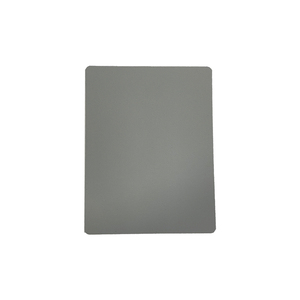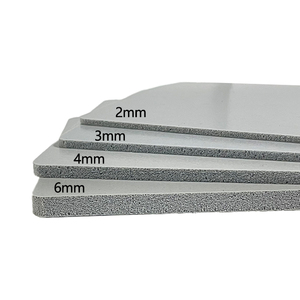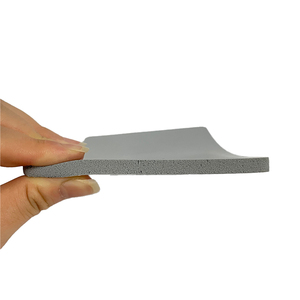
All categories
Featured selections
Trade Assurance
Buyer Central
Help Center
Get the app
Become a supplier

(8 products available)














































There are some types of sound attenuation blankets. Here is a look at some of them.
The soundproof blanket is also known as an acoustic blanket or sound blanket. It is manufactured using a sound-absorbing material. This material is covered using an industrial vinyl that is UV and tear-resistant. The blanket is designed to reduce noise levels significantly. It is ideal for use in construction sites and in a residential area. The sound barrier blanket is available in different sizes and can be hung on a fence or wall.
Acoustic panels are one of the types of sound attenuation blankets. They are constructed using a wooden frame. This frame is filled with a sound-absorbing material. The panels have a fabric cover that allows sound waves to enter the panel. The sound waves are then absorbed by the sound-absorbing material. These panels are available in different sizes and can be installed on walls or ceilings.
These are also known as sound control window blankets. They are made of heavy material that is designed to block sound. The curtain has a layer of sound-absorbing material and a high-density material. It is available in different sizes and can easily be hung on a curtain rod. The curtain is ideal for reducing noise from outside and can also be used to improve the acoustics in a room.
Sound blankets are made of thick and dense material. They are used to cover loud equipment and machinery to reduce noise levels. The blanket has grommets around the edges. These grommets allow the blanket to be hung vertically or horizontally. 3 sound attenuation blankets are available in different sizes and can also be used to cover windows.
These are also known as sound deflectors. They are made of wood, plastic, or foam. The sound waves hit the surface of the diffuser. The waves are then scattered in different directions instead of being reflected. This helps to reduce echo and reverberation in a room.
Isolation pads are placed under speakers or studio monitors to reduce vibration and improve sound quality. They are made of foam, rubber, or cork. The pads are designed to absorb vibrations and prevent them from traveling through the floor or other surfaces.
Soundproofing blankets have various features that determine their effectiveness in reducing or eliminating noise. Here are some of the features of sound attenuation blanket insulation:
Soundproofing blankets use different acoustic materials to absorb sound waves. Some of the materials used include:
This is a number between 0 and 1. It shows how well an acoustic blanket absorbs sound. An NRC of 0 means the material absorbs no sound, while an NRC of 1 means it absorbs all the sound. Soundproof blankets have NRC ratings of between 0.5 and 1. They are suitable for recording studios and home theaters.
Soundproofing blankets have an outer cover that protects the inner sound-absorbing material. The cover is made from durable materials like polyester or vinyl. It protects the inner material from dust, debris, and moisture. The outer cover is also aesthetically pleasing and available in different colors and designs.
Soundproofing blankets are easy to install. Some models have grommets and Velcro straps for easy hanging. They are also lightweight and portable. This makes them suitable for temporary soundproofing.
Sound attenuation fire blankets used in industrial applications have a fire rating. This shows how well the material resists flames. They are constructed with flame-retardant materials for safety in high-risk areas.
Soundproofing blankets come in different sizes and thicknesses. The size ranges from 4 x 8 feet to 4 x 12 feet. The thickness varies from 1 to 4 inches. Thicker blankets are more effective at absorbing sound than thinner ones. However, they are also heavier and may require structural support.
Thermafiber sound attenuation fire blankets are used in many industries and areas where controlling noise is important. Here are some of the most common applications of sound attenuation blankets:
Construction sites use sound attenuation blankets to reduce the noise from heavy machinery and construction activities. These blankets are hung around the site or on the fences to absorb and block the noise. They are essential in areas near residential zones or where noise pollution is a concern.
Factories and industrial plants have many noisy machines. Sound blankets are installed in the factories to separate and enclose the machines, reducing the noise that spreads in the plant. This creates a conducive working environment for the factory workers.
Sound blankets are used in home studios, professional studios, and theaters to absorb and block sound reflections. They are hung on walls, ceilings, and floors to create a soundproof environment that prevents sound from leaving the room or entering the room from outside.
Commercial buildings use sound blankets to reduce noise from HVAC systems, plumbing, and other sources of noise. The blankets are installed in walls and ceilings to create a quiet and comfortable space for employees and clients.
Sound attenuation blankets are commonly used in outdoor events such as concerts, festivals, and sporting events. They are hung around the stages and seating areas to minimize the sound that travels to nearby areas. This helps in reducing noise complaints from people living near the event.
Sound blankets are used in residential areas such as highways, railways, and airports to reduce noise. They are hung on walls and fences to block and absorb the noise from the traffic. This creates a quiet environment for the people living nearby.
Engine rooms on boats and ships have noisy engines. Sound blankets are installed in the engine rooms to absorb the noise from the engines, creating a quieter environment on the ship. They are also used in ports and shipyards to reduce the noise from ships.
Compressor stations for oil and gas pipelines produce a lot of noise. Sound attenuation blankets are used to enclose the compressors and pipelines, reducing the noise that is produced by the station. This reduces noise pollution in the area.
When choosing soundproofing blankets for sale, consider the following factors to ensure the merchandise meets their customers' demand.
Most soundproofing blankets come with sound attenuation material like mineral wool and fiberglass. These materials are good at reducing sound waves and are popular in soundproofing materials. The two are preferred because they are affordable and easy to work with. They also come with flame retardants, a feature that is essential in any soundproof room. The soundproofing materials are available in multiple densities, making it easy to choose one that will meet the desired soundproofing needs. For instance, high-density materials are effective at reducing noise levels, and they are suitable for busy, noisy areas.
Soundproofing blankets come in different sizes and weights. It's important to consider the blanket size to ensure it fits the area to be soundproofed. Also, consider the weight since it is directly related to the soundproofing effectiveness. For the most part, heavy blankets are more effective at reducing noise. At the same time, the size and weight of the blanket are important for anyone looking to install the blanket on their own. A small and lightweight blanket is easy to handle, and a large blanket requires more than one person to put in place.
When purchasing soundproofing blankets, it is important to consider the quality of the materials used to make the blanket. The quality of the soundproofing material will determine the blanket's effectiveness in blocking noise. A high-quality blanket will effectively reduce noise, while a low-quality one will not. Therefore, it is important to get a soundproofing blanket from a reputable company since they use high-quality soundproofing materials.
When choosing the right soundproofing material to wholesale, it is important to consider the blanket's flame resistance. It is essential to get a blanket that is flame resistant since it can be used in areas where there is a risk of fire outbreak. Most soundproofing blankets use flame-retardant materials, and their coating is essential for reducing the noise and the risk of fire outbreak.
Q1: Are sound blankets only useful for sound studios?
A1: Not really. Sound blankets are useful in many other areas, including construction sites and homes. They can be laid over fences to block traffic noise and, more commonly, installed in walls and ceilings to reduce noise between rooms.
Q2: Are sound blankets permanent?
A2: Sound blankets are not permanent. While some can be permanently installed, like those attached to walls or ceilings to block noise between rooms, there are temporary sound blankets that are placed on floors, over doors, and in windows.
Q3: Do soundproofing blankets eliminate noise entirely?
A3: No, soundproofing blankets do not eliminate noise completely. However, they can significantly reduce noise levels, making it possible to carry out activities in a quiet environment.
Q4: Do all sound blankets look the same?
A4: No. Soundproofing blankets come in different colors and designs. For instance, some have grommets and can be hung like curtains, while others look like regular blankets and are laid on the floor or over doors.
Q5: Can soundproofing blankets be used outside?
A5: Yes, soundproofing blankets can be used outside. However, not all are designed to be used outside. Therefore, it is essential to check the manufacturer's recommendations to know if the blanket can be used outdoors.